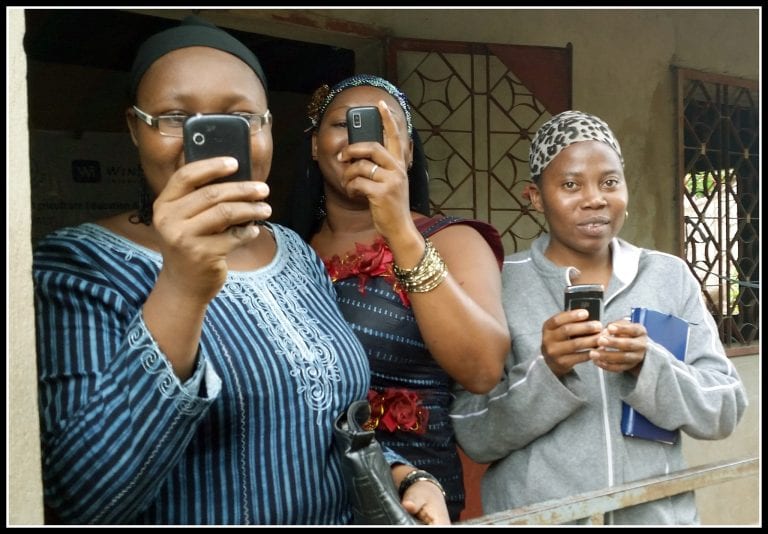The tropes of a Silicon Valley icon’s backstory glitter throughout Jim Fruchterman’s biography. The founder of the non-profit technology companies Benetech and Tech Matters began his career by dropping out of an elite school. He is a serial venture founder, bearer of spectacular failure and course corrections on the path to success, he has earned multi-million dollar grants and his resume sparkles with a succession of what would be dream jobs in the eyes of mere mortals. A key difference is the profits. Mr. Fruchterman left the cash scramble of the for-profit world early in his career, devoting himself instead to the development of technologies that change lives in underserved communities.
In 1981, Mr. Fruchterman left a PhD program at Stanford to work for a rocket startup. He gracefully weathered early failure when the rocket engine he helped build exploded on a launchpad. He recalibrated and went to work for a company that developed text-scanning software. Combining a text-scan with an early version of a text reader created the prototype of a system that reads books to blind people. But the company’s leadership did not believe the market for such software was big enough. The company had veered from his goals, so Mr. Fruchterman left to found his own enterprises. He eventually bought a license to the text-reading software from his former employer, then went on to found the non-profit Benetech to develop digital tools for the blind.
From E4C’s archive: Benetech’s (former) VP Patrick Ball Discusses Tech that Protects Evidence of Human Rights Abuse
Benetech has found an unexpected application for its technology in conflict zones, discovering and preserving evidence of humanitarian crimes. And Mr. Fruchterman continues the founding spree. His newest organization is Tech Matters, a consultation firm for non-profits. He describes Tech Matters as an ‘anti-consultancy’ that talks non-profits out of using custom or new technologies, arguing that other methods are often more practical.
As busy as he surely is, Mr. Fruchterman was game to answer Engineering for Change’s questions, some in engrossing detail. These are five questions for Jim Fruchterman.
E4C: Would you please give examples of tech-deficiency in non-profit organizations? What are they doing wrong?
JF: Wow, I think that describes most nonprofits! There are a set of challenges which all interact:
- Most nonprofit leaders underestimate the value of tech tools and data to the organization and its mission.
- Most donors do the same, and resist funding tech.
- A “cult of custom” tends to dominate the tech-needs conversation: “Our nonprofit isn’t like the others, so we need tech that does exactly what we want.”
- Nonprofits which do spend money on tech end up paying a greater proportion of their funding on custom solutions, which often fail, are overly rigid, difficult to maintain, or many years behind the times in their technology.
- The market for tech solutions for nonprofits is weak, so that any companies which do try to meet these needs are underfunded, which means they are not particularly responsive and often lag years behind the times in technology.
- Fads which die off quickly in the for-profit sector when the business case doesn’t materialize linger for years longer in the nonprofit sector (apps, blockchain, hackathons, etc.).
It’s quite a dysfunctional field. Of course, business is full of failure, but for every 10 startups which quickly crater, there’s probably one that is quite successful and quickly goes to scale, reaching a significant amount of the potential market. The weaker feedback mechanisms in social good means that failures last longer and big successes actually aren’t big by for-profit standards, and have a hard time reaching the people who need them.
I bet at least 90 percent of the apps developed for nonprofits have failed to deliver the desired impact. In many cases, it’s because that app had no reason to exist.
A classic example is the smartphone app. I bet that at least 90 percent of the apps developed for nonprofits have failed to deliver anywhere close to the desired impact. In many cases, it’s because that app had no reason to exist. For example, apps for dealing with a single instance of something (one human rights abuse, one request for information) are almost uniformly going to fail, because no actual user in need is going to search their friendly app store for an app for reporting something, or learning something. Real users use search, or text someone, or make a phone call for one-off tasks. However, that doesn’t stop consultants from building apps with use profiles (or in the typical case, dis-use profiles) like these. There are good use cases for apps in the nonprofit world, and successful apps, but they are few in comparison to what’s been built!
E4C: How do you fix those mistakes?
JF: My approach is taken straight out of modern design thinking (which I didn’t not create, but happily use). Rather than telling me why the blockchain will (magically) solve this problem, or why your proposed app will help people, I suggest we start by identifying the problem we want to solve, and who is the person we’re going to help solve it. What are they doing today instead of the proposed piece of tech? What incentives and disincentives shape their behavior? Using a new piece of technology involves behavior change: are the benefits of your proposed solution so powerful that they will motivate humans to change their behavior?
Much of my value is talking people out of bad ideas.
In a very few rare cases, the product/use fit might actually point to a blockchain-based database, or an app. But, usually not. I joke about being an anti-consultant. Much of my value is talking people out of bad ideas, and putting them on the road to thinking about how tech could be helping their social mission in reality.
E4C: What are ‘systems technologists,’ and how can they improve global development work?
JF: I’m writing a piece on this question, which should come out later this year when we actually announce Tech Matters!
The short version is: the social change sector generally wants to solve a social problem, or make a big dent in it. That’s systems change. Systems change needs more than one organization: it needs thousands or even more, generally pulling in the same direction. And that absolutely requires software and data capabilities. So, a systems technologist is a tech strategist who thinks at the systems level, and figures out how to build software, standards and platforms which make an entire field more powerful in reaching the shared systems change goal.
E4C: In the description of Tech Matters’ work with non-profits, one step is to partner with an organization’s competitors. What does that look like in practice?
JF: When a new industry is created in tech, there’s generally a standards body. In software, there’s often an open source software project (or five) at the core of that new industry. Standards and open source projects are typical places where competitors find it in their interest to collaborate with each other. How do we build shared infrastructure and reduce the friction of cooperating, so that each company can focus on the magic of their product/technology value proposition? That’s today’s tech industry, with competitors working together on items of shared interest.
How do we build shared infrastructure and reduce the friction of cooperating so that each company can focus on the magic of their product?
Software as a Service (SaaS) is a classic example of where competitors share technology at the platform level. No restaurant wants to also be building the point-of-sale system for their restaurant: you pay a vendor service fees and your patrons can pay the bill. Instead of worrying about tech, the restaurateur worries about competing based on the quality and value of their food (and a bunch of other things). The same should be true in the social good sector when it comes to tech. It is true in a couple of areas, like fundraising and accounting software. But it’s rare for nonprofits to collaborate on standards, open source glue software and shared platforms.
This is of course what Benetech has been doing for decades, working on all three of these pieces. Tech Matters is simply replicating this proven industrial model, which Benetech has applied in several fields, to even more fields. Two quick examples:
- Competitors in the environmental field (most of the big international NGOs like The Nature Conservancy, WWF, Audubon, etc.) came together to make best practice standards in planning and running environmental projects. They came to Benetech to build an open source product management tool (Miradi) to implement those standards in a way usable by NGO staff across the entire field. After six years, Benetech moved on to other projects, but was able to turn the project over to the NGOs to continue maintaining (they hired an environmentally savvy software consulting company to keep it updated). Five years later, Miradi is still going strong.
- Benetech was founded to create scanning systems for blind and (later) dyslexic people to scan books which would then be read aloud. In essence, they were creating their own ebooks. Benetech then took two parallel tracks to enable systems change.First, it built a SaaS platform to replace the need for individuals to scan books, because the Bookshare online library aggregated the scanning efforts of the entire community (one person scans the latest Harry Potter, one proofreads it, and 5000 readers don’t scan anything). Bookshare is now the SaaS platform for a dozen countries’ national library for people with disabilities, because the economics of a shared online platform are powerful, especially when the people running it want maximum impact, not maximum profits.The second track was a standards route. An incredible tech leader (who happens to be blind, and who happens to work for Benetech at the moment) took over the leadership of the EPUB standards body. Now, the ebooks created by the publishers are already 90+% accessible, or more, to people with disabilities. 90% of the 5-10,000 new books going each month into Bookshare come from publishers for free in EPUB, which Bookshare automatically transforms into accessible formats. And, Benetech is helping the publishers create their commercial EPUB book to work great for people with disabilities, which should start reducing the need for a disability-specific library in the future.
E4C: Speaking of Benetech, their work in conflict zones is deeply interesting. What are they working on now?
JF: The biggest project Benetech is working on right now is justice and accountability in Syria. For the first time, our challenge in a civil war situation is not too little data, but now too much data. Millions and millions of videos which the UN (and others) can’t possibly watch in realistic amounts of time on limited budgets. We’re helping groups with too many videos to use machine learning/AI to sort through millions of videos to zero in on the videos which are most important for building war crimes cases.
For the first time, our challenge in a civil war situation is not too little data, but now too much data.


No Comments.